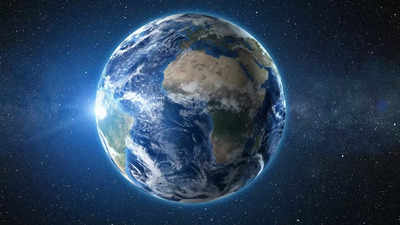- News
- Education News
- Learning with TOI News
- How the Earth formed and life evolved: Explained
Trending
This story is from May 23, 2023
How the Earth formed and life evolved: Explained
The Earth formed from dust and gas, with particles coming together through collisions to form planetesimals and protoplanets, like the Earth. The Earth's surface cooled, rain formed oceans, and an atmosphere developed. Life began in the oceans and evolved from simple organisms to complex plants and animals, with changes in the environment and genetic mutations contributing to the diversity of life on Earth.

Image Source: Freepik
The Earth formed about 4.6 billion years ago. It all started with a cloud of gas and dust in space called a nebula. This nebula contained tiny particles that gradually came together due to gravity. As more and more particles collided, they formed larger objects called planetesimals.
These planetesimals eventually grew in size and became protoplanets.One such protoplanet was our Earth. Over time, the protoplanet Earth kept getting bombarded by other space rocks, which caused intense heat. This heat melted the rocks and metals, and as a result, the heavy materials sank to the center, forming the Earth's core. The lighter materials floated to the top and formed the Earth's crust.
After the Earth's surface cooled down, it started to rain for millions of years. This rain formed oceans, and the Earth's atmosphere was also created. The atmosphere consisted of different gases like nitrogen, carbon dioxide, water vapor, and small amounts of other gases.
Life on Earth began in these oceans around 3.5 billion years ago. Simple forms of life, such as single-celled organisms called bacteria, appeared first. These organisms were able to survive and multiply in the water.
As time passed, animals evolved from these early organisms. They gradually developed different body structures, enabling them to move and adapt to different environments. From small and simple creatures, more complex animals emerged, including fish, reptiles, mammals, and eventually humans.
Throughout this evolutionary process, various factors such as changes in the environment, competition for resources, and genetic mutations played a role in shaping the diversity of life on Earth. Different species evolved and adapted to different habitats, leading to the incredible variety of life forms we see today.
In summary, the Earth formed from a cloud of gas and dust, and over billions of years, it went through processes like planetesimal formation, differentiation, and the development of oceans and atmosphere. Life began in the oceans and gradually evolved from simple organisms to complex plants and animals through a process of adaptation and genetic change.
(The content is generated with the assistance of Artificial Intelligence)
These planetesimals eventually grew in size and became protoplanets.One such protoplanet was our Earth. Over time, the protoplanet Earth kept getting bombarded by other space rocks, which caused intense heat. This heat melted the rocks and metals, and as a result, the heavy materials sank to the center, forming the Earth's core. The lighter materials floated to the top and formed the Earth's crust.
After the Earth's surface cooled down, it started to rain for millions of years. This rain formed oceans, and the Earth's atmosphere was also created. The atmosphere consisted of different gases like nitrogen, carbon dioxide, water vapor, and small amounts of other gases.
Life on Earth began in these oceans around 3.5 billion years ago. Simple forms of life, such as single-celled organisms called bacteria, appeared first. These organisms were able to survive and multiply in the water.
Over a long period, these simple life forms evolved and became more complex. They started to develop new features and structures, such as cells with a nucleus. This led to the emergence of more advanced organisms, like algae and eventually, plants.
As time passed, animals evolved from these early organisms. They gradually developed different body structures, enabling them to move and adapt to different environments. From small and simple creatures, more complex animals emerged, including fish, reptiles, mammals, and eventually humans.
Throughout this evolutionary process, various factors such as changes in the environment, competition for resources, and genetic mutations played a role in shaping the diversity of life on Earth. Different species evolved and adapted to different habitats, leading to the incredible variety of life forms we see today.
In summary, the Earth formed from a cloud of gas and dust, and over billions of years, it went through processes like planetesimal formation, differentiation, and the development of oceans and atmosphere. Life began in the oceans and gradually evolved from simple organisms to complex plants and animals through a process of adaptation and genetic change.
(The content is generated with the assistance of Artificial Intelligence)
End of Article
FOLLOW US ON SOCIAL MEDIA










